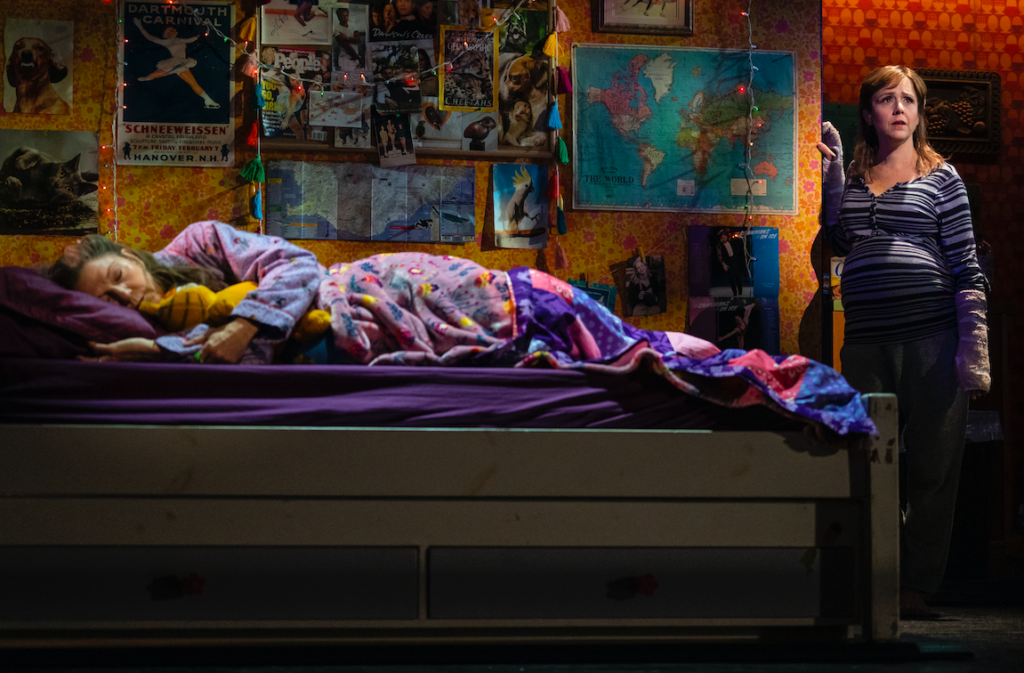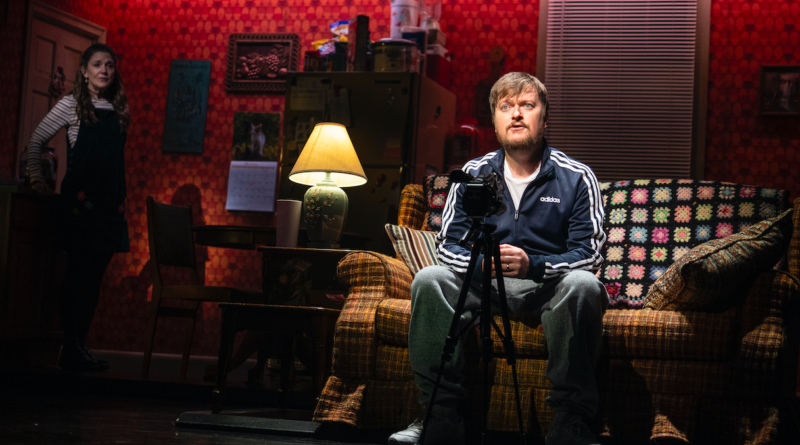INTERVIEW: David Zinn brings suburban Jersey to life in ‘Kimberly Akimbo’
Photo: Steven Boyer plays the character of Buddy in the Broadway musical Kimberly Akimbo. Victoria Clark portrays the title character. Photo courtesy of Joan Marcus / Provided by Polk & Co. with permission.
Kimberly Akimbo, the new Broadway musical playing the Booth Theatre, follows the adventures of Kim, a 16-year-old facing an uncertain future because of a rare genetic condition. Kim, played quite movingly by Victoria Clark, ages faster than her friends, so as she’s coming of age in a high school setting, she is also facing stares and side comments on why she appears to be much older. Her family life is not terribly supporting, with a mother (Alli Mauzey) and father (Steven Boyer), who are seemingly more excited for the baby to come than the daughter in front of their eyes.
David Zinn is the scene designer for the musical, which features a book and lyrics by David Lindsay-Abaire (the show is actually based on his original play). Jeanine Tesori is the composer, and Jessica Stone is the director. The creative team has been together for years, from the development of the show to the off-Broadway run at the Atlantic Theater Company.
“I had been in Jeanine’s orbit for a decade, which is a very happy orbit to be in for me because I love her music so much,” Zinn said in a recent phone interview. “And I knew Jessica Stone. We had never worked together but were friendly, and she called, must have been 2018 or something, to see if I was interested in working on this latest Jeanine project, which of course I was very interested.”
Zinn had some unique challenges when designing Kimberly Akimbo. For starters, the story jumps around suburban New Jersey to many different locations, including the inside of Kim’s house, the local high school and a skating rink. This presented some puzzling obstacles.
“The play goes a million places,” he said. “It’s in two parts of a skating rink, a living room, and then a bedroom, and then the living room and the bedroom. … It’s original venue was the Atlantic Theater, which is a wonderful venue, but small, so we knew there was going to be some sort of physical need to control the vocabulary and make a box or make a room that felt like it could hold a lot of different locations.”
Zinn needed to design a place that could be specific when the musical called for intimacy and familial space, but also these sets need to have an “easy flow” to them so that they could transition from scene to scene without much delay.
“So I looked at a lot of skating rinks,” said Zinn, who is also represented on Broadway with Funny Girl. “Also looked at roller rinks, places where people gather like that, and looked at some architecture, spent a lot of time on Google Maps and in the real estate section of New Jersey. It’s a musical about a lot of things, but it’s a musical about the idea of a home, for better and for worse; that figures very prominently, so I wanted to find a place where the architecture of a house and the architecture of a skating rink could come together and house all these other locations. That’s sort of where I started.”
Zinn remembers his first meeting with Stone. The director gave him a beautiful photograph of a scene at night. There wasn’t much to the image, except a nondescript parking lot and a sad, abandoned armchair placed underneath a streetlight. There was a deep blue sky on the horizon.
“She was like, ‘I know nothing is set in a parking lot,”” Zinn remembers. “But she said that this somehow feels like the world to me, and I think what that told me was that there could be some collision. There could be some inside/outside. The rules for the space could be liquid, could hold both interiors and exteriors. Also that deep, beautiful blue … no matter where you are there’s that hour of sunset that’s really beautiful, even if you’re in the shittiest place. You’re like, the sky is really pretty tonight. That element, the romance or beauty and longing for that, wanted to be evident as well.”
The scenic designer, who has also designed for The Minutes, Diana, Torch Song and The Humans, often develops a vision of what he sees the stage looking like for a paying audience, but he also has to make that vision have practicality. The dream, in other words, cannot be too dreamy.
“My vision usually accommodates actors getting from one side of the stage to the other,” he said. “Cost is a thing that reins in my vision occasionally, but I will say, what you try to do is make an emotional world for a show that can exist at different scales, if that makes sense. So I’m trying to capture the emotional heart of this piece, and we can spend a lot of money on that and enhance it in X, Y and Z ways. And we can spend less money on that but still hold the heart of the show. I think, in some ways, that’s the trick of design, which is allowing yourself to dream, but also know that it’s an idea that has practical sides to it, both getting people from left to right, which is an issue, but also getting things to come on and off stage, just the scale of how things operate.”
Zinn added: “So we definitely cut a lot of things that we wanted to have happen, but I don’t miss them. I feel like the show we see feels like the show we intended, and I think it’s because it goes back to those initial impulses, which are poetic and emotional.”
By John Soltes / Publisher / John@HollywoodSoapbox.com
Kimberly Akimbo, with scenic design by David Zinn, continues at the Booth Theatre on Broadway. Click here for more information and tickets.


